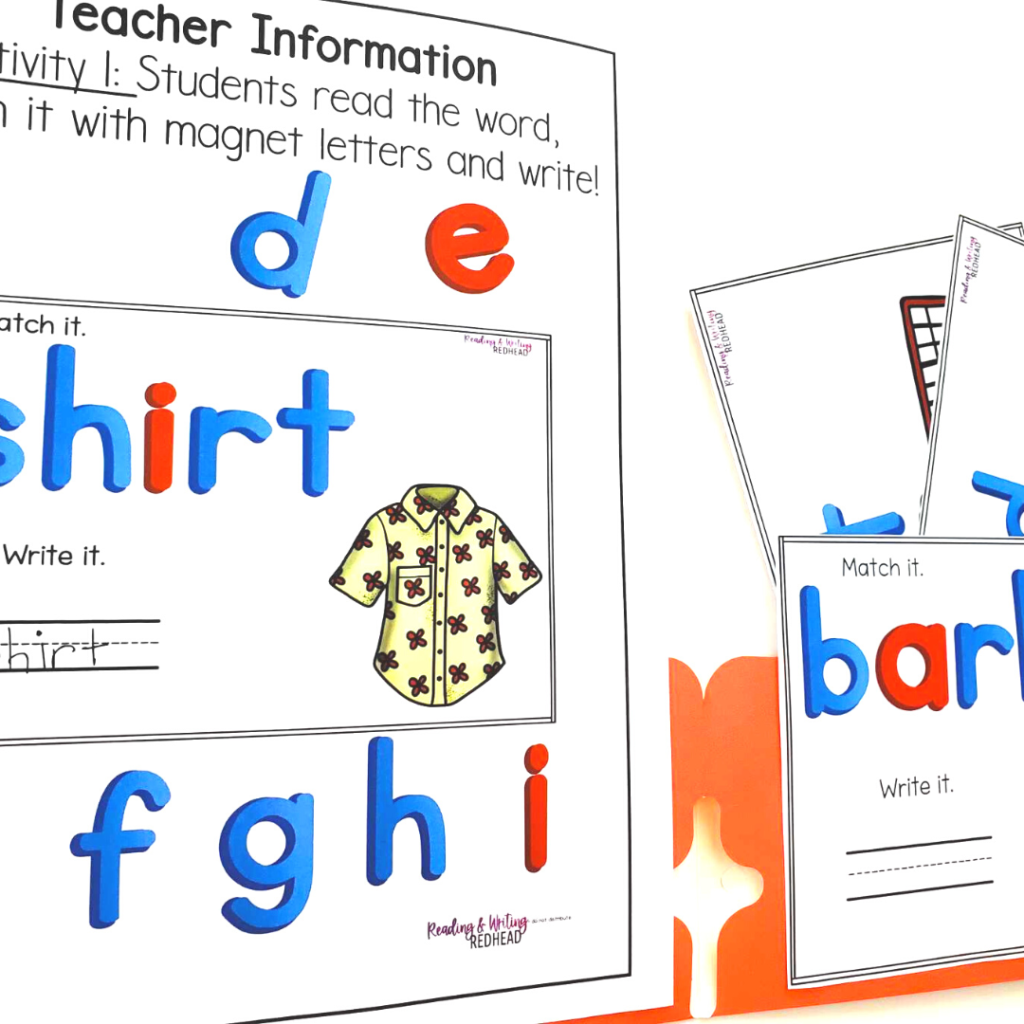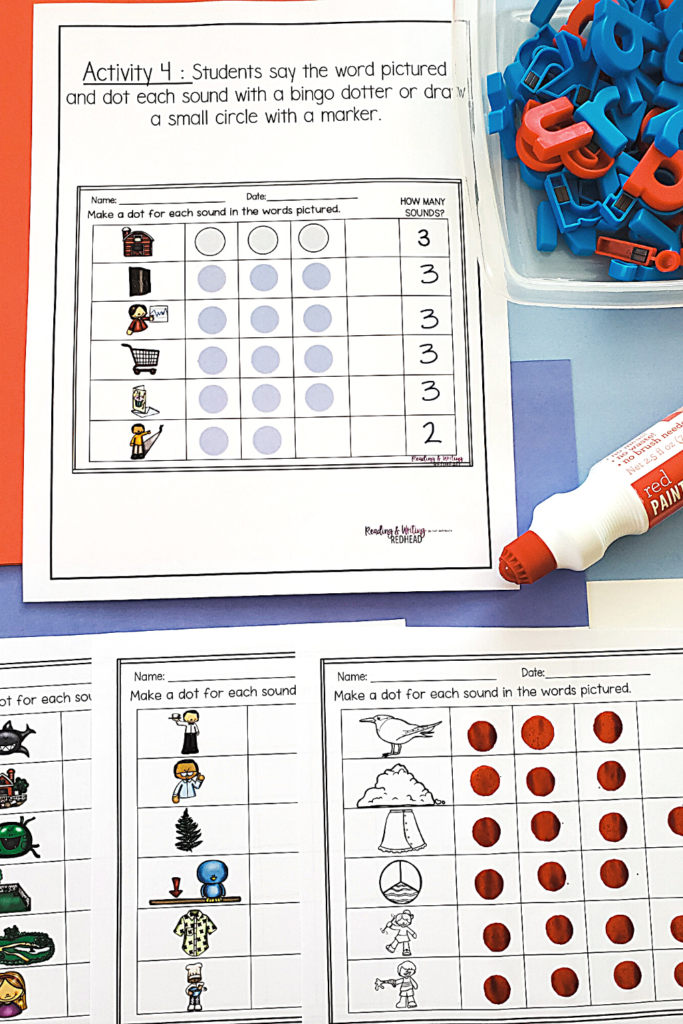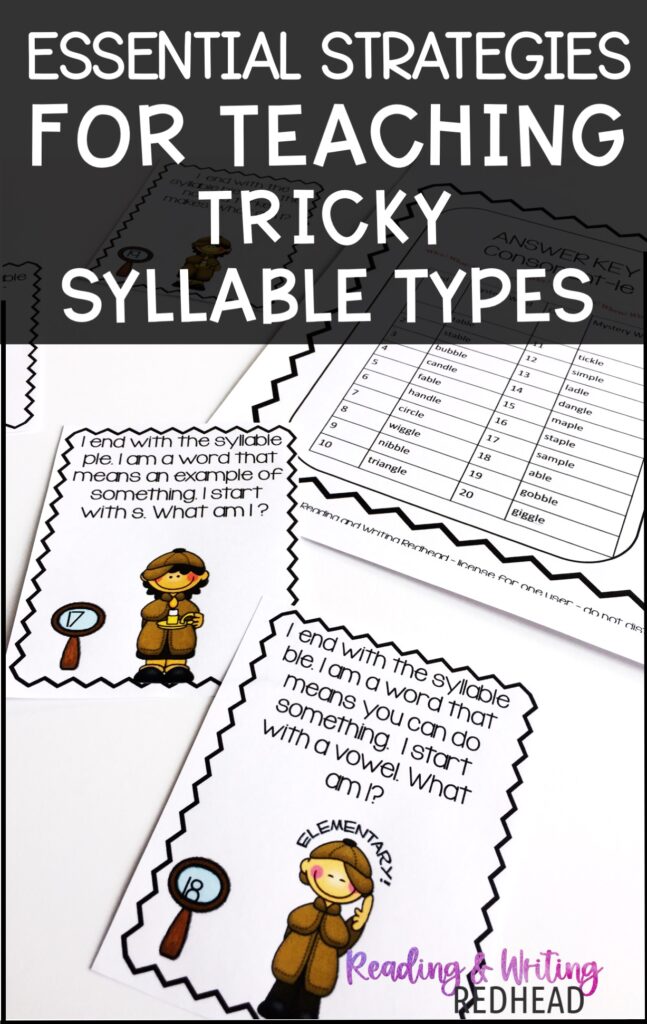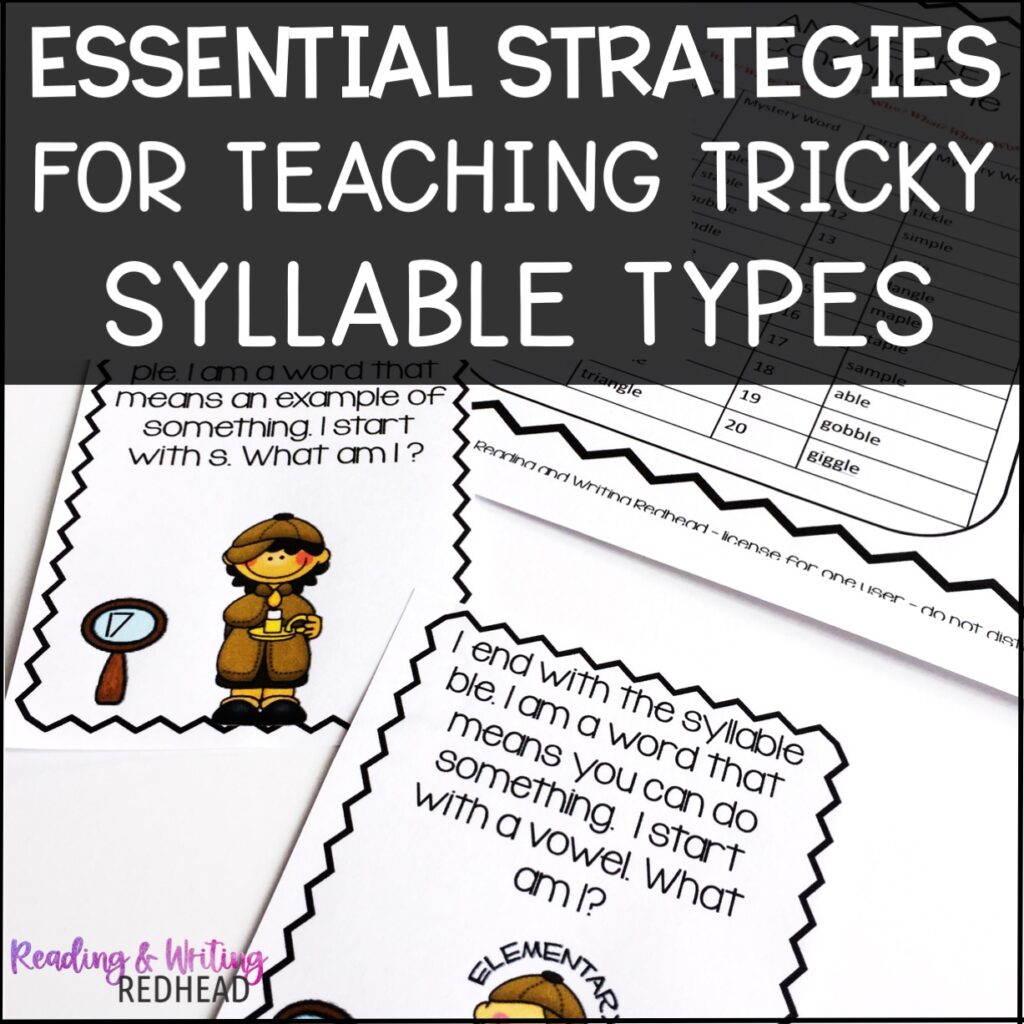
Cracking the Code: Essential Strategies for Teaching Tricky Syllable Types Consonant-le and R-controlled Vowels
Mastering tricky syllable types can be a stumbling block for young readers. Tricky syllable types, such as consonant-le and r-controlled vowels may need extra attention!
This blog post provides effective strategies to help students master these challenging patterns. By implementing these essential strategies, you’ll give your students the tools they need to become confident readers who have a good grasp on spelling.
Let’s crack the code together!
Use Visuals and Syllable Division Posters
Here are some tips for two kinds of tricky syllable types – consonant le (final stable syllables) and r controlled vowels (ar, er, ir, or, and ur).
- Consonant-le: Create posters showing the consonant-le syllable division rule. Highlight the consonant and the “le” in different colors, and show examples like “apple” and “table” where the syllable is divided before the consonant-le.
- R-Controlled Vowels: Use posters or flashcards with visuals of common r-controlled vowel combinations. Show and explain how the “r” changes the vowel sound.
Bingo
Create bingo cards with words containing different syllable patterns. Call out words and have students find the matching word on their cards. I love making free bingo boards at the Class Tools website!
Syllable Memory Game
I am also a sucker for using memory/concentration games for phonics. Try creating matching pairs of words with the same syllable type. Students can play a memory game to practice identifying and recalling these patterns. I usually just write on index cards with pencil (so it doesn’t show through when the cards are face down) to make these games.
These activities can help make tricky syllable types more accessible and engaging for elementary students
Keep reading for even more tips!
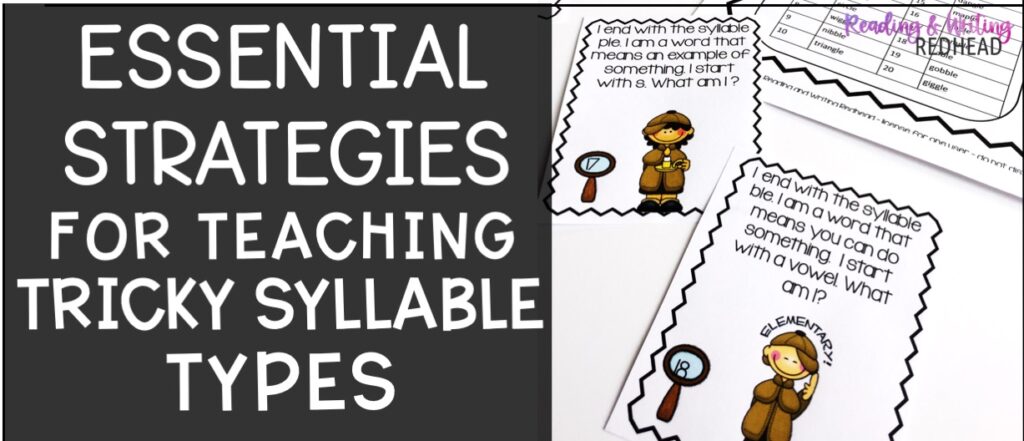
Interactive Read-Alouds with Highlighting
While reading, emphasize r-controlled vowels or consonant-le words and have students echo-read or choral-read these words. You can also highlight these words in the text (trying using removable highlighting tape) for visual reinforcement.
Try using decodable phonics readers that focus on these syllable types for even more bang for your buck!
Multisensory Writing Activities
Have students write words in the air, on a whiteboard, using clay, in sand, or with wikki sticks while saying the sounds out loud (ie shark would be “/sh/ /ar/ /k/”. This combines visual, auditory, and kinesthetic learning.
Syllable Type Riddles
Create riddles using words with specific syllable patterns. Have students guess the word and identify the syllable type. OR… save time and…
Use Ready to Go Activities from Teachers Pay Teachers
Wouldn’t be it easy for you if you had ready-to-use activities and resources from Teachers Pay Teachers to incorporate into your lessons for teaching tricky syllable types? I have two suggestions for you! First, the word riddle task cards are great because they:
- Build phonics skills: Riddles reinforce letter-sound relationships and help students develop phonemic awareness.
- Enhance problem-solving: Students must use critical thinking to decipher the clues and guess the mystery word.
- Increase engagement: The riddle format adds an element of excitement and makes learning more enjoyable.
Introducing The Mystery Word Riddle Resources
To support your consonant-le syllable instruction (also available for other syllable types like r-controlled vowels), Teachers Pay Teachers has a comprehensive resource packed with engaging activities. This resource includes:
- 40 task cards with challenging riddles
- Color and black and white versions for differentiation
- An answer key for easy grading (and helpful so you can leave for subs)
- A record sheet for student tracking
- Two ABC order activities for additional phonics practice
How to Use This Resource
This resource can be easily integrated into your classroom in various ways:
- Reading center: Place the task cards in a center for independent practice.
- Scoot game: Have students move around the room to solve riddles at different stations.
- Read the room activity: Scatter the task cards around the classroom for students to find and solve.
- With a para or a volunteer: Students could work with a para or a volunteer to receive a little extra support.
- At the teacher table: Also perfect for working with you at the teacher table!
Take a peek below – you can see some of the task cards with riddles, the recording sheet, an answer key and a bonus challenge in which students put the words in ABC order. For differentiation, you will also find a word bank for students who might need a bank of words to choose from when they solve the riddles, and an ABC order activity with only ten words, instead of twenty.
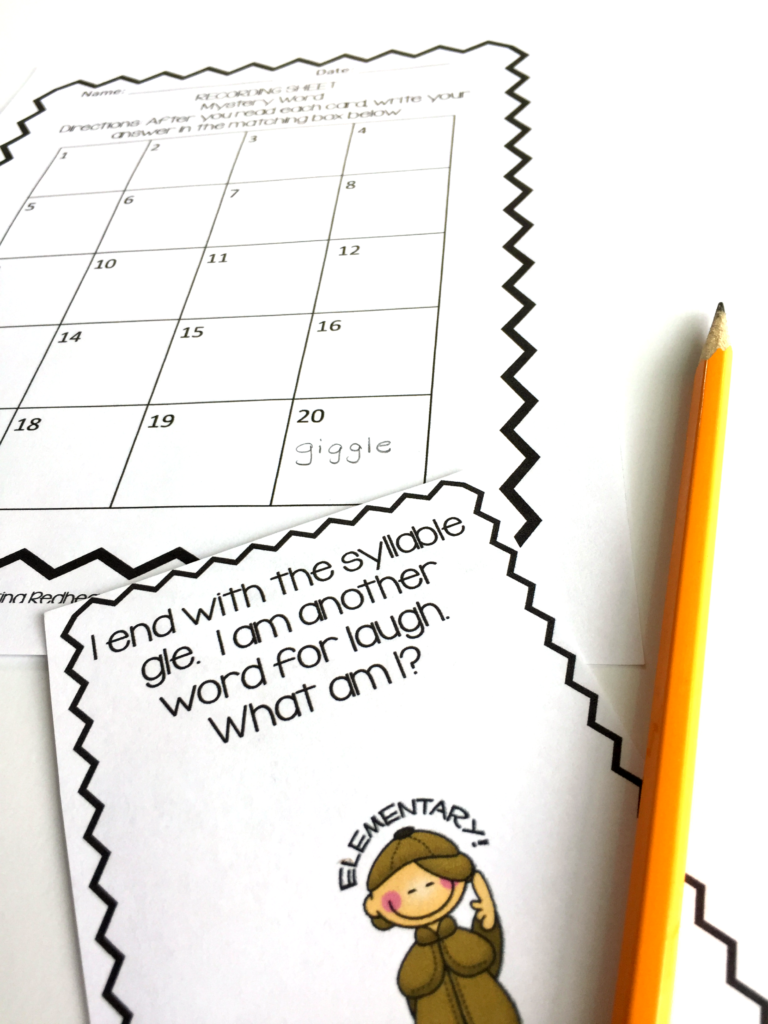
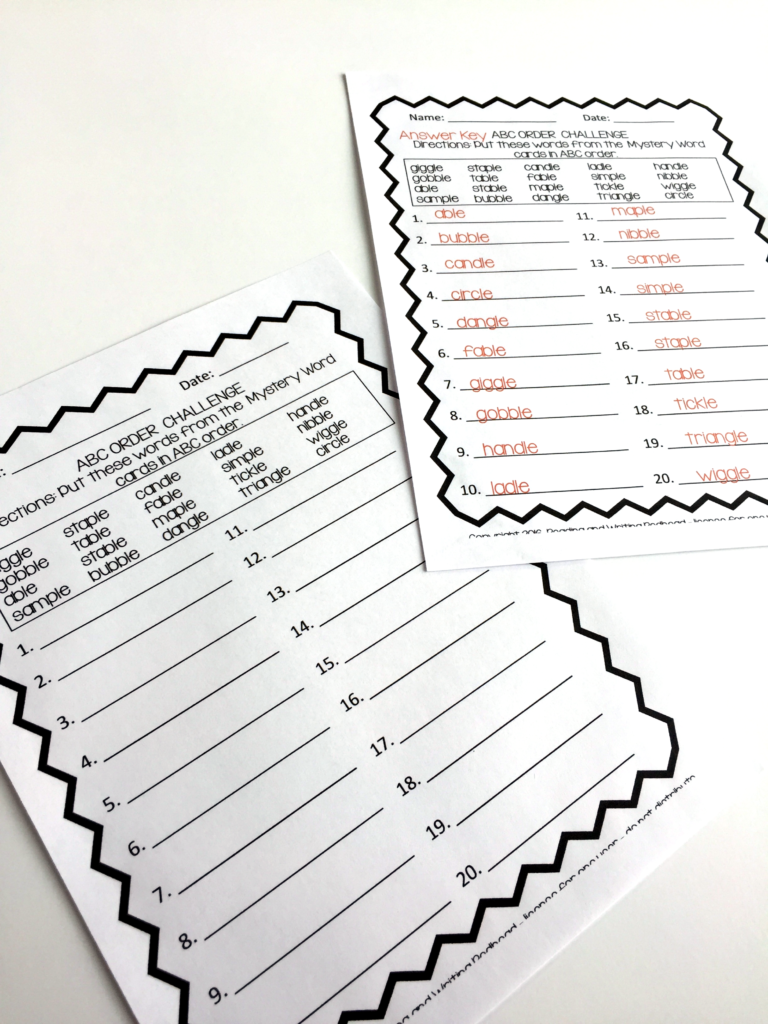
Download the resource today and watch your students’ confidence soar!
It is also available for r controlled vowels and with other phonics skills in a bundle! With the bundle, you will save 30% over getting each syllable type word riddle resource separately!
Introducing the R-Controlled Vowel Science of Reading Center Activities
(also available for consonant-le and other syllable types!)
My second suggestion for you is to try the Science of Reading Center Activities. An effective way to teach r-controlled vowels is through hands-on phonics activities. By incorporating manipulatives like magnetic letters you can make learning this skill fun and engaging.
This resource offers a variety of differentiated task cards to help students practice r-controlled vowels. These engaging activities will challenge and motivate students while reinforcing key phonics concepts.
Key Features of This Resource
- Variety of activities: Includes four different activities to keep students engaged.
- Differentiation options: Offers both color and black and white versions for various learning styles.
- Hands-on learning: Requires the use of magnetic letters or letter tiles.
- Answer keys: Provides teachers with easy grading and feedback.
- Teacher tips: Offers guidance and suggestions for effective implementation.
Check out what the task cards look like – you can see students will place manupulative letters on top of the letters in the word shirt, then write it on the lines. I like to laminate the cards so kids can write on them with a wipe off marker and then pass the card to another student.
Also included in all of the Science of Reading Phonics for Small Groups activities, including the r controlled resource, are “Dot the Sounds” activities where students check a picture, say the word, and count how many sounds are in each word. They they dot each sounds with a bingo dauber or draw a little circle with a marker and record the number of phonemes. Another fun activity to reinforce phonics patterns!
Download the resource today and watch your students’ reading skills soar!
Remember, this resource is also available for other syllable types like consonant le words! Grab the bundle too so you can save almost 30%!
.
Five Star Reviews:
Check out some teacher feedback – I know I always read feedback when I am looking for something, so let me share it so you don’t have to go on a hunt!
Feedback for the word riddles: “My students love a good riddle! And these were a great way to practice -le words while keeping them very engaged! Great resource.”
For a magnetic letter resource (this teacher used the suggestion of having kids put their magnets on baking sheets): “I was so impressed that this resource had everything I needed to make sure my students were engaged in their centers. I was happy to see them so excited to use the baking sheets again!”
Other blog posts you may want to check out:
- Boost Your Phonics Lessons: 4 Engaging Activities for Extra Practice
- Mastering ELA Skills with Interactive Notebooks
- 5 Powerful Tips for Teaching Capitalization and Punctuation
- Ignite Creativity and Supercharge Your Students’ Writing Skills
If you want to save this blog post for later, pin this image below! If you try any of the strategies, or grab the resources, let me know! Please take a moment on Facebook to leave feedback. It means so much to me!
Good luck this week! You got this!!


